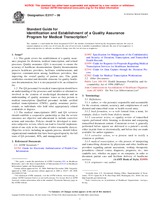Potřebujeme váš souhlas k využití jednotlivých dat, aby se vám mimo jiné mohly ukazovat informace týkající se vašich zájmů. Souhlas udělíte kliknutím na tlačítko „OK“.
ASTM E2117-06
Standard Guide for Identification and Establishment of a Quality Assurance Program for Medical Transcription
Automaticky přeložený název:
Standardní Průvodce pro identifikaci a Zřízení programu zabezpečování jakosti pro lékařské přepis
NORMA vydána dne 15.10.2006
Informace o normě:
Označení normy: ASTM E2117-06
Poznámka: NEPLATNÁ
Datum vydání normy: 15.10.2006
Kód zboží: NS-44360
Počet stran: 5
Přibližná hmotnost: 15 g (0.03 liber)
Země: Americká technická norma
Kategorie: Technické normy ASTM
Anotace textu normy ASTM E2117-06 :
Keywords:
accuracy, audit, author, consistency, dictated content, dictation, management, medical transcription, patient safety, quality assurance, review, transcribed content, ICS Number Code 71.040.50 (Physicochemical methods of analysis)
Doplňující informace
| Significance and Use | ||||||||||||
|
This guide lists the essential components of a quality assurance program/quality improvement program for medical transcription and is applicable in all work environments. It describes factors that should be considered when evaluating the individuals and processes responsible for producing patient care documentation and for establishing procedures to address and resolve problems that may arise in dictation and transcription. It clarifies who has the authority to make decisions regarding transcription style and editing and to resolve conflicts. This guide may be used to develop a quality assurance program for individual medical transcriptionists, medical transcription departments within healthcare institutions, medical transcription businesses, and authors of dictation. A quality assurance program verifies the consistency, correctness, and completeness of dictation and transcribed reports, including the systematic identification and resolution of inaccuracies and inconsistencies, according to organizational standards. Merely proofreading reports is not equivalent to a quality review process, which should involve comparison with the dictation at least part of the time and review for meaning of content all of the time. Quality is fundamental to the patient record, and clear, complete, accurate patient care documentation helps control the rising cost of health care and contributes to patient safety. The quality of the final report is the responsibility of both the author and the medical transcriptionist. It is the result of teamwork between the person dictating and the individual transcribing. It should be noted that while production standards are important, their value is diminished if quality is lacking. Likewise, transcribing dictation verbatim may not result in quality documentation or clear communication. It is the transcriptionist’responsibility to recognize, identify, and report voice files that lack accuracy, completeness, consistency, and clarity for corrective action. |
||||||||||||
| 1. Scope | ||||||||||||
|
1.1 This guide covers the establishment of a quality assurance program for dictation, medical transcription, and related processes. Quality assurance (QA) is necessary to ensure the accuracy of healthcare documentation. Quality documentation protects healthcare providers, facilitates reimbursement, and improves communication among healthcare providers, thus improving the overall quality of patient care. This guide establishes essential and desirable elements for quality healthcare documentation, but it is not purported to be an exhaustive list. 1.2 The QA personnel for medical transcription should have an understanding of the processes and variables or alternatives involved in the creation of medicolegal documents and an understanding of quality assurance issues as they pertain to medical transcription. Qualified personnel include certified medical transcriptionists (CMTs), quality assurance professionals, or individuals who hold other appropriately related credentials or degrees. 1.3 The medical transcriptionist (MT) and QA reviewer should establish a cooperative partnership so that the review outcomes are objective and educational to include corrective actions and remedies. Policies should be developed to minimize subjective review, which can lead to forceful implementation of one style at the expense of other reasonable choices. Objective review, including an appeals process, should follow organizational standards that have been agreed upon by the full team of QA personnel, MTs, and management staff. |
||||||||||||
| 2. Referenced Documents | ||||||||||||
|
Doporučujeme:
Aktualizace zákonů
Chcete mít jistotu o platnosti užívaných předpisů?
Nabízíme Vám řešení, abyste mohli používat stále platné (aktuální) legislativní předpisy.
Chcete vědět více informací? Podívejte se na tuto stránku.




 Cookies
Cookies
